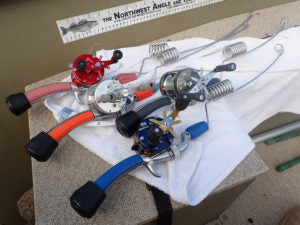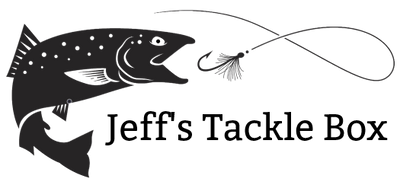
Bait casting is a powerful, accurate fishing system—but, without practice, the pursuit is frustrating. The first thing to do is to decide which rig to purchase. Bombarded with ads from every direction, making the right choice can be difficult. I’ll try and give you a place to start.
First, do not be swayed by all the hype you see on TV and in the magazines. There is no magic reel that will never backlash or add huge distances to a cast.  Those things are the result of how you develop your angling skills and how well you set up your individual reel. The key is to start with a proven reel design that fits your hand and match it to a good rod you can handle easily. It really is all about the fit and how the outfit feels to you. There are two basic types of bait casting reels: low profile and round. Low profile reels are sleek and racy looking. Good examples are Shimano, ABU, and Daiwa. The round reels are taller and have round frames. The same reel companies previously mentioned have reels in that class as well.
Those things are the result of how you develop your angling skills and how well you set up your individual reel. The key is to start with a proven reel design that fits your hand and match it to a good rod you can handle easily. It really is all about the fit and how the outfit feels to you. There are two basic types of bait casting reels: low profile and round. Low profile reels are sleek and racy looking. Good examples are Shimano, ABU, and Daiwa. The round reels are taller and have round frames. The same reel companies previously mentioned have reels in that class as well.
The prices range from 60 dollars to over 500 dollars. Now we need to address the confusion of deciding how much you need to spend to have something that works. I have some simple suggestions, based on my own experience, to make this easier. I normally recommend for a beginner a basic reel in the 60 to 140 dollar range. Good examples are the ABU round reels, such as the C3 series with the 4500 or 5500 reels. These are found at most sporting goods stores and will cost you 60 to 80 dollars. Make no mistake about reels in this price range– they work. You don’t have to spend hundreds of dollars to get a nice reel. I use them regularly and have no problem catching fish. The basic design has been around for decades and proven to catch fish anywhere in the world. Mine have been around a long time, cared for properly and some are now approaching 40 years old.
One last important reel issue is which hand you will use to cast. Most casting reels have their handle on the right side. The standard casting method is to cast right handed, then switch the outfit to the left hand to reel in. It sounds complicated at first, but becomes natural within a short time with practice. More and more reels are now becoming available with left hand retrieve, so you don’t have to switch hands. If you are just learning to cast, practicing with using either hand can be a real advantage.
Now that you’ve found your reel, you’ll need a rod to match. Again, the same price range of 60 to 140 dollars will get things started. Don’t go overboard on heavy actions and big long handles. A great starting point is medium action, rear handle of no more than eight inches or so, and a total rod length of 5’6” to 7’. Get the size you are most comfortable with. You don’t need a long rod to cast far. The longer rods are harder to transport and somehow manage to find car doors and tree limbs very easily. Try out the rod on the reel at the store and check the feel. There are many rod companies to pick from–just be sure it’s a known brand so, if there is a problem, you aren’t stuck with a lemon. Your tackle store can help you with the brands best suited in your area. You can also check out the catalogs from Bass Pro Shops and Cabelas. These firms have additional in-house rod brands that are superb and well covered with guarantees.
Line is the next consideration for you new bait casting rig. Look for a line rating of 10 to 20 lb test. The best line weight for beginning bait casting is 12lb test. Start  with a premium mono line. Don’t buy cheap line. Use well known brands: Berkley, Stren, Sufix, or YoZuri. There are others, but these are nationally distributed and easy to find. A solid basic product that is universally available is Berkley Big Game 12lb test. I use this line and have been happy with it for years. For teaching purposes, I use a version called Solar that has a fluorescent green color. It’s easy to see and manage while learning, and relatively inexpensive.
with a premium mono line. Don’t buy cheap line. Use well known brands: Berkley, Stren, Sufix, or YoZuri. There are others, but these are nationally distributed and easy to find. A solid basic product that is universally available is Berkley Big Game 12lb test. I use this line and have been happy with it for years. For teaching purposes, I use a version called Solar that has a fluorescent green color. It’s easy to see and manage while learning, and relatively inexpensive.
Now you have gotten the rig together, spooled on the line. Time for casting practice to begin. The best place is not on the water, but on the lawn. Buy some of the plastic practice plugs and try a little “lawn bassin”. It’s a great way to learn and helps you practice the casting part instead of the fishing part. I do this daily at home just to keep my casting eye in shape and it pays big dividends on the water. Start with a ½ ounce practice plug and tie it on your line with the canoe man’s loop knot. (Check the archives for my previous article on knots.)
Casting is a learned process. Become familiar with the instructions that came  with your reel on how to use the casting brakes and spool controls. Start with easy tosses and progress as you get comfortable. Don’t go for distance–go for accuracy. A small plastic bucket is a great target to begin with. Keep at it and learn to control the outgoing line with your thumb. In no time you’ll be casting like pro and hitting right where you need to catch the big ones.
with your reel on how to use the casting brakes and spool controls. Start with easy tosses and progress as you get comfortable. Don’t go for distance–go for accuracy. A small plastic bucket is a great target to begin with. Keep at it and learn to control the outgoing line with your thumb. In no time you’ll be casting like pro and hitting right where you need to catch the big ones.
